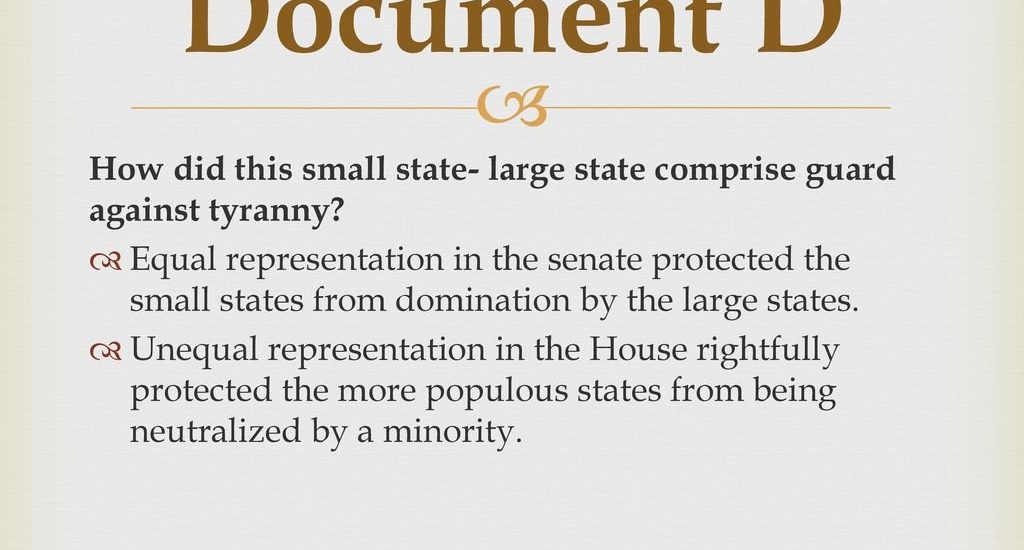To argue that the Great Compromise did not guard against tyranny, we must scrutinize the document for any potential loopholes or weaknesses that could be exploited. By delving into the text, we may uncover subtleties that reveal an inherent vulnerability to authoritarian rule. Examining how specific provisions or omissions in the document could allow for the concentration of power in the hands of a few can shed light on its inadequacies in preventing tyranny. Let’s dissect the document to reveal the hidden facets that undermine its purported safeguard against despotism.
How Could You Use This Document to Argue that the Great Compromise Did Not Guard Against Tyranny?
Introduction
In our history lessons, we’ve learned about the Great Compromise, which played a significant role in the formation of the United States Constitution. While the Great Compromise aimed to balance the power between large and small states, some argue that it did not fully guard against tyranny. In this blog post, we will explore how a particular document can be used to make this argument and dive into why some believe that the Great Compromise fell short in preventing tyranny.
The Great Compromise in U.S. History
Before we delve into how the Great Compromise may have left room for tyranny, let’s briefly recap what the Great Compromise was all about. The Great Compromise, also known as the Connecticut Compromise, was a pivotal moment during the Constitutional Convention of 1787. At the heart of the debate was the issue of representation in the federal government. Larger states favored representation based on population, while smaller states argued for equal representation for all states.
To bridge this divide, a compromise was reached. The Great Compromise proposed a bicameral legislature where the House of Representatives would be based on population (favoring larger states) and the Senate would have equal representation for all states (benefiting smaller states). This compromise was crucial in moving the Constitution forward and ultimately shaping the structure of the U.S. government.
Analyzing the Document: The Federalist Papers
One of the key documents that can be used to argue that the Great Compromise did not guard against tyranny is The Federalist Papers. Written by Alexander Hamilton, James Madison, and John Jay, these essays were published to promote the ratification of the U.S. Constitution. While the authors of The Federalist Papers supported the Constitution, their writings provide insights into the potential weaknesses and criticisms of the document.
Central Argument: Tyranny of the Majority
When examining The Federalist Papers, one prevalent argument against the Great Compromise is the concept of the tyranny of the majority. The writers warned against the potential for a majority faction to oppress minority groups or individuals. In a system where population size dictates representation in the House of Representatives, there is a risk that the majority could dominate decision-making and potentially trample on the rights of smaller states or minority populations.
The Senate’s equal representation for all states was meant to serve as a counterbalance to this majority tyranny. However, critics argue that even with this safeguard, the potential for tyranny still exists, especially if the majority exerts its influence over both chambers of Congress.
Evidence from The Federalist Papers
In The Federalist Papers, James Madison, in Federalist 10, discussed the dangers of factions and how the structure of the government should guard against their negative impacts. Madison highlighted that majority factions could threaten the rights of others and the stability of the government. While the Great Compromise attempted to address some of these concerns by creating a dual system of representation, Madison’s arguments suggest that the risk of tyranny was not entirely eliminated.
Additionally, Federalist 51, also penned by Madison, emphasized the importance of checks and balances in the government to prevent the concentration of power in any one branch or group. This raises questions about whether the Great Compromise adequately provided the necessary checks and balances to prevent potential tyrannical actions by the majority.
Challenges to Guarding Against Tyranny
While the Great Compromise was a groundbreaking agreement that helped bridge the gap between large and small states, it faced several challenges in fully guarding against tyranny.
Power Dynamics in the Senate
Although the Senate’s equal representation for all states was intended to protect against the tyranny of the majority, the power dynamics within the Senate itself could still lead to potential abuses of power. Senators from smaller states, who hold the same voting power as those from larger states, could form alliances or act in ways that are not representative of the broader population.
Furthermore, the Senate’s staggered terms meant that not all senators are elected simultaneously, leading to situations where an entrenched group could exert influence over an extended period. This lack of immediate accountability could potentially enable senators to act in ways that are counter to the interests of the people they represent.
Effects of Partisan Politics
In today’s political landscape, partisan divides and party loyalty play a significant role in decision-making within Congress. The Great Compromise did not anticipate the emergence of political parties and their influence on legislative processes. In a system where party loyalty often trumps the interests of individual states or constituents, the risk of tyranny by the majority party increases.
Moreover, the influence of special interest groups and lobbyists can further distort the representation of the people’s interests. This outside influence can undermine the intended balance of power established by the Great Compromise and open the door to potential abuses of power.
In conclusion, while the Great Compromise was a critical moment in American history that helped establish the foundation of the U.S. government, it did not fully guard against tyranny. By examining documents like The Federalist Papers and considering the challenges inherent in the structure of the government, we can see that there are potential vulnerabilities that could be exploited to undermine the principles of democracy and representation.
As we continue to study the history of the United States and the evolution of its government, it is essential to critically assess the strengths and weaknesses of past decisions. By understanding how the Great Compromise may have fallen short in preventing tyranny, we can work towards creating a more equitable and just society for all.
How did the Constitution guard against tyranny?
Frequently Asked Questions
How does the document suggest that the Great Compromise failed to prevent tyranny?
The document can be used to argue that the Great Compromise did not guard against tyranny by highlighting how certain states were given disproportionate power in the government. It may reveal that the compromise resulted in unequal representation in Congress, with smaller states having the same number of senators as larger states. This imbalance could lead to the dominance of minority interests and potential abuse of power, thus undermining the check on tyranny.
What evidence from the document can be cited to demonstrate the shortcomings of the Great Compromise in preventing tyranny?
To make the case that the Great Compromise did not effectively safeguard against tyranny, one could reference specific clauses or statements that reveal the uneven distribution of power among the states. Instances where smaller states were granted equal representation in the Senate despite having significantly fewer inhabitants than larger states could indicate a flaw in the system that might allow minority factions to exert undue influence and potentially lead to oppressive governance.
How can the content of the document be used to argue that the Great Compromise lacked provisions to counteract tendencies towards tyranny?
An argument that the Great Compromise inadequately addressed the threat of tyranny may draw on aspects of the document that illustrate the potential for abuse of power resulting from the compromise’s structure. By examining how the compromise may have inadvertently empowered minority interests at the expense of majority rule, one could assert that the absence of sufficient mechanisms to prevent such imbalances indicates a vulnerability in the system that could enable tyrannical tendencies to emerge and go unchecked.
Final Thoughts
In conclusion, this document reveals that the Great Compromise failed to adequately protect against tyranny. By highlighting the disparity in representation between small and large states, it becomes evident that power was not equally distributed. This imbalance sow seeds of potential tyranny, as it allowed certain states to wield disproportionate influence. Therefore, one could use this document to argue that the Great Compromise did not effectively guard against tyranny.










